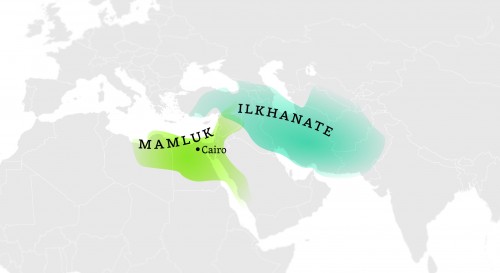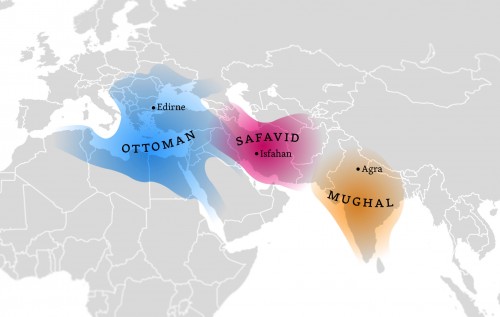Yesterday I gave my first classroom lecture ever. It was a mild disaster, as you might expect (I certainly did), but it was also a good learning experience. My goal was to give the students a broad overview of Islamic architecture that would be relevant to a course that is otherwise concerned with European architecture (primarily Italian Renaissance and British Neoclassicism) between 1400 and 1800. The class is also cross-listed as a Growth and Structure of Cities course, so I consciously made an effort to approach monuments within a larger urban context, although I now realize I probably placed more focus on the urban aspects of the monuments than I should have. I structured the class around 5 moments in the history of Islamic architecture, contextualizing monuments in terms of the empires in which they were produced (a questionable structuring principle, but an easy and perhaps necessary one for an introductory lecture):
- Umayyad – Dome of the Rock
- Mamluk – Sultan Hasan Madrasa/Mausoleum Complex
- Ottoman – Selimiye Camii
- Safavid – Shah Abbas urban renovations
- Mughal – Taj Mahal
Because the class deals so much on the revival of the classical style in Renaissance Italy, I thought the Dome of the Rock would provide an interesting case study in the manner and meaning of stylistic and structural imitation in the Early Medieval period. The Sultan Hasan complex represents a mature, distinctive style and incorporates many of the standard features of a mosque/madrasa. The Selimiye Camii provides a point of contact with the Italian tradition: Marc’antonio Barbaro, a Venetian ambassador to Istanbul, writes home of its construction, and on his return to Venice he supported one of Palladio’s centrally-planned (and ultimately rejected) designs for the Redentore. It also raises the question of how architects relate to an ur-monument (in this case Hagia Sophia), one of the themes that runs throughout the course. The palatial/civic renovations of Isfahan raise issues of how monuments relate to their landscape, and how architecture produces power through spatial interrelations. The Taj Mahal is one of the most elegantly structured monuments within the canon of Islamic architecture, and yet there is little evidence of an active architectural discourse in Mughal India — a strong contrast with the self-promotion of Italian Renaissance and Ottoman architects. This barely fits together in my head, or in this paragraph, so I can only imagine how disjointed it must have seemed to the students.
Since I won’t get the chance to lecture again for a while, I want to take this opportunity to record some of the things that I think went well, as well as some of the things that didn’t.
Things I’m happy with:
- maps
- attempting to integrate different technologies of observation (panoramas and photosynths)
I had fun using Illustrator to make maps that would help students understand the geographical and political context of the monuments. Here’s the one I made to introduce the Sultan Hasan Complex:

And the one I used for the three early modern monuments:

Things I didn’t do so well:
- putting key terms on slides – muqarnas, mihrab, minbar, chihar bagh, polylobed…
- following my notes
- discussing the monuments as architecture (students need a walkthrough of Creswell groundwork before they can get to the exciting Necipoglu discussion of the dynamics of the Safavid gaze)
- figuring out a way to navigate photosynths/panoramas without switching out of lecture mode
Some of these are easy to fix — putting key terms on slides is a no-brainer. Others, however, are harder. Making sure that you’ve said everything you want to say about a monument before moving on is hard when you’re nervous and worried about the pace of your lecture. Only further experience lecturing will relieve the anxiety that led me to backtrack awkwardly or simply skip important and interesting material that I couldn’t smoothly integrate into the lecture as it progressed. This is also complicated by the fact that I’m still figuring out how to structure a discussion of a monument for a lecture, which is very different from the more Socratic or discussion-based approaches that I have experienced as a student. Because there was no assigned reading, I didn’t feel comfortable asking students questions (one of the easiest ways to get them engaged and actively thinking about material). I think this was a missed opportunity.
Try again. Fail again. Fail better.

Your maps are always sooooo pretty. Teach me your cartographical secrets, Alex!
It seemed to me that one of the hardest things about this particular lecture was going to be tying the material in with the themes of the course, but it looks like you found a good way to do that. It must have been difficult to condense centuries of architecture into 75 minutes (or however long), but I suspect that, whether or not it seems that way now, having a “long view” like that towards the beginning of the course might help the students keep track of how the western material (which they’ll receive in much more detail) might all fit together.